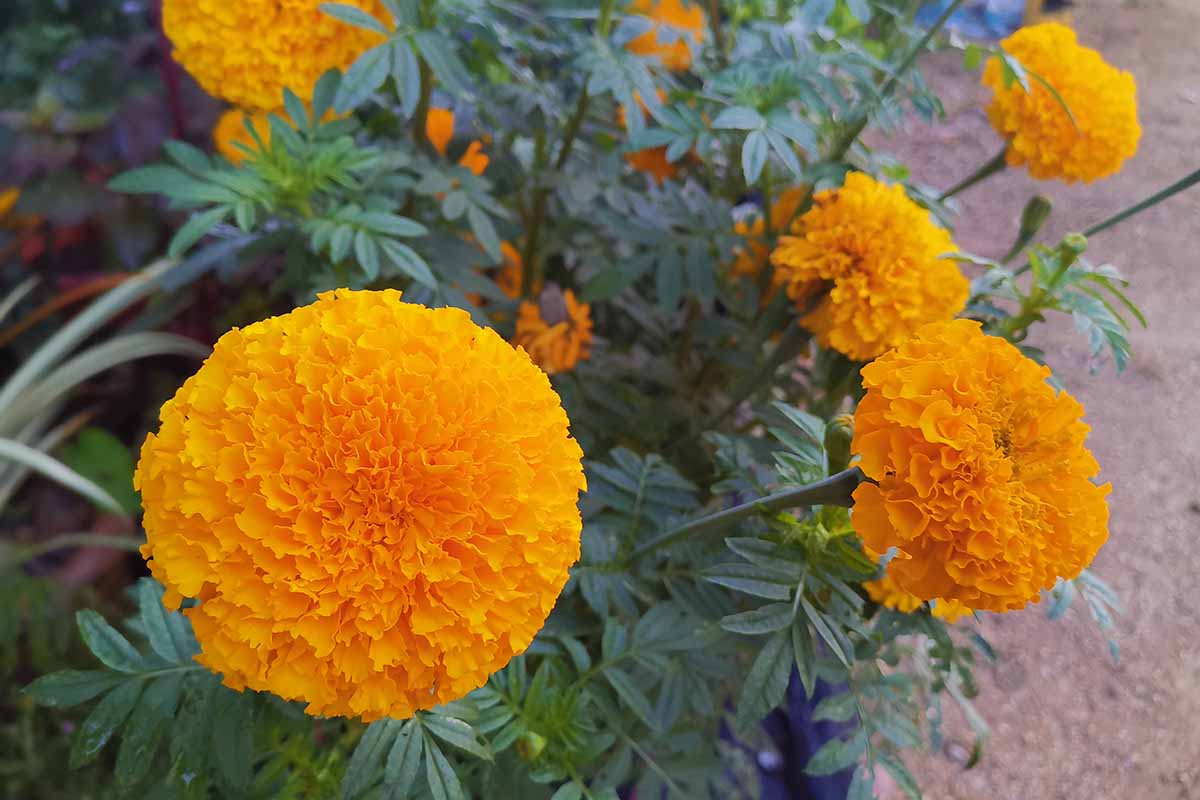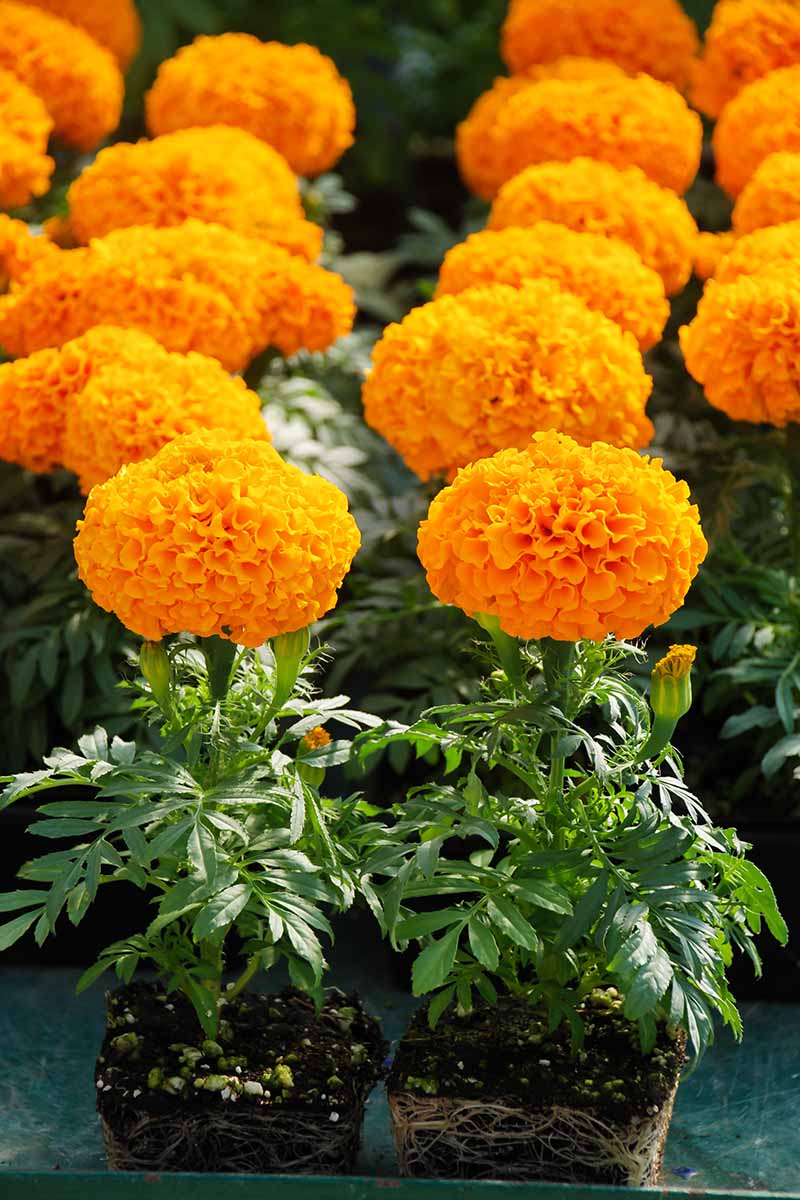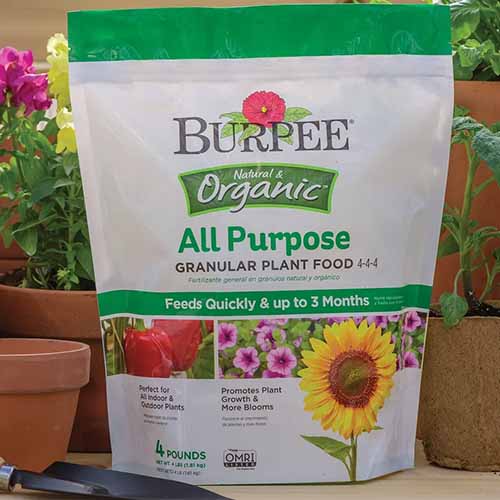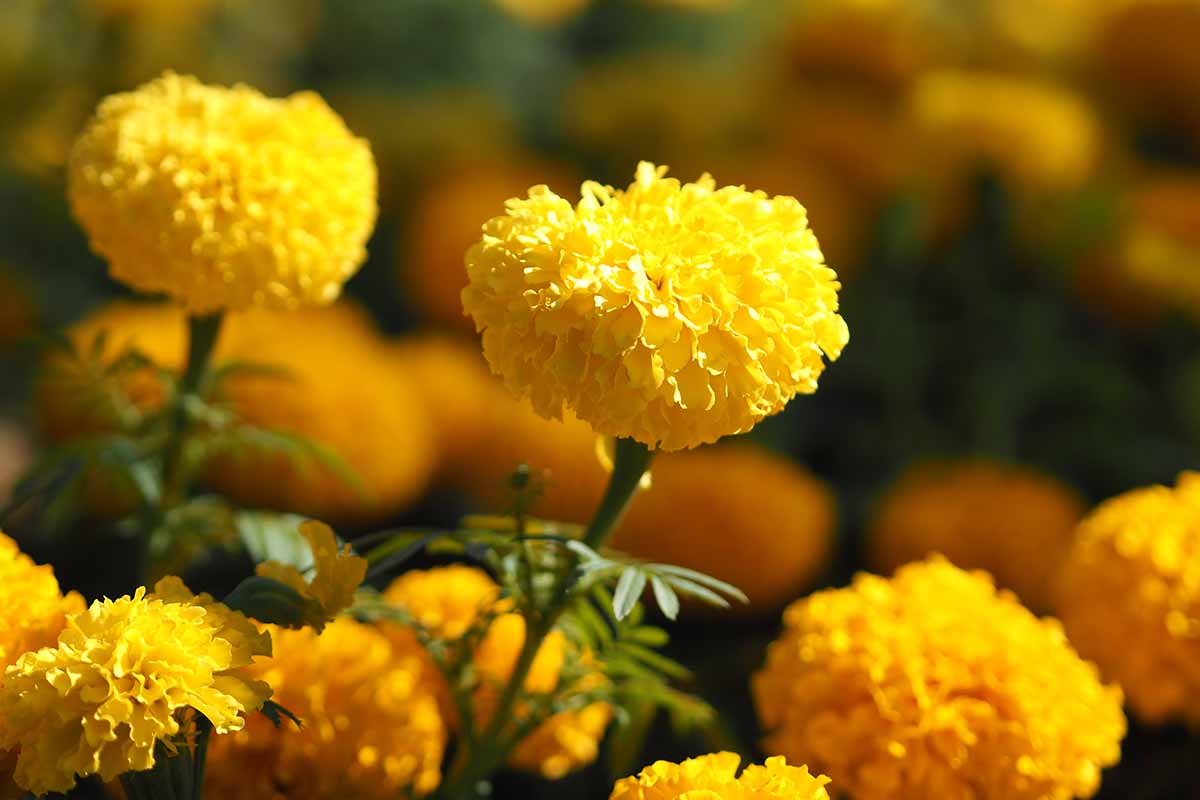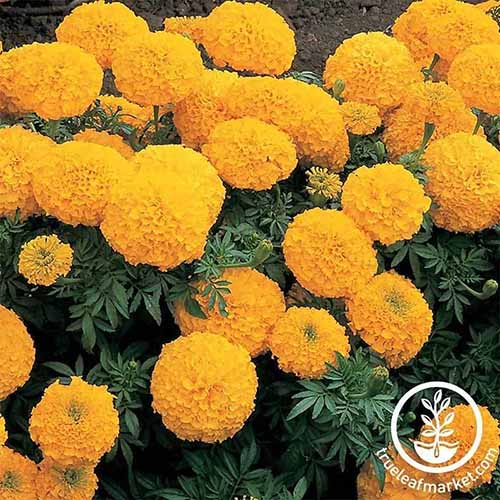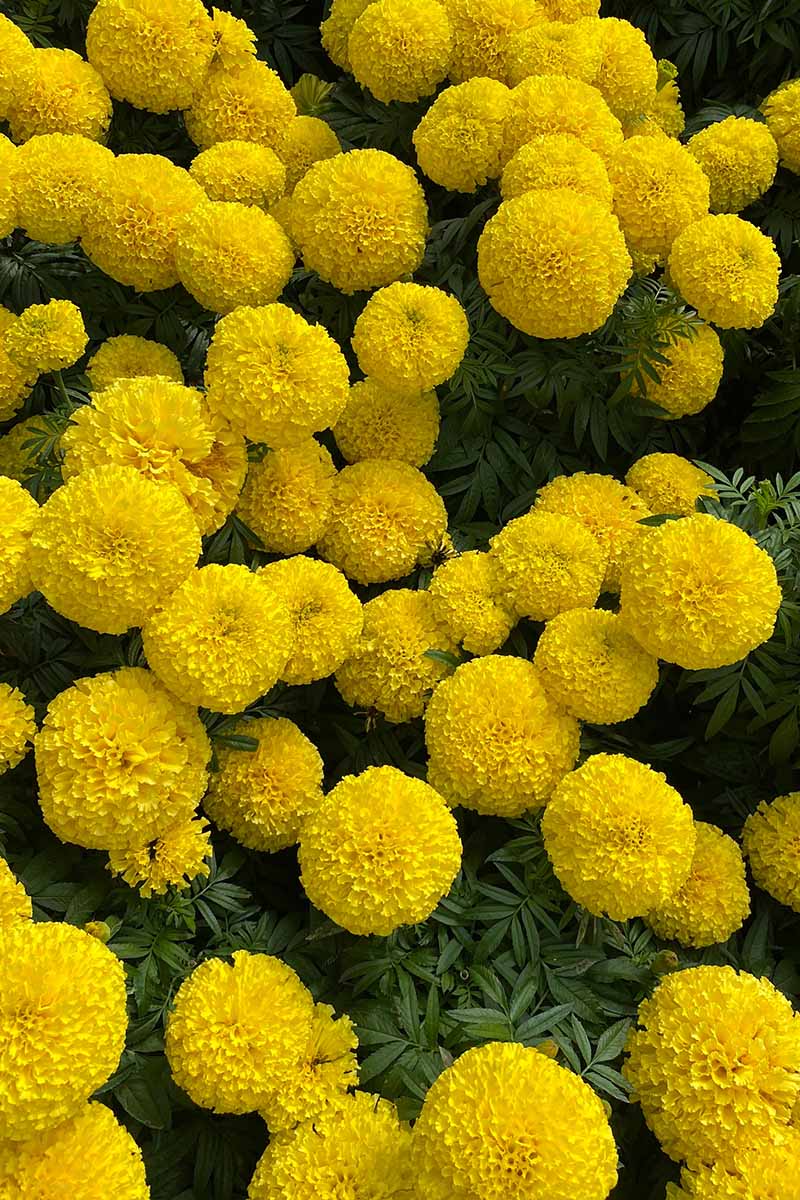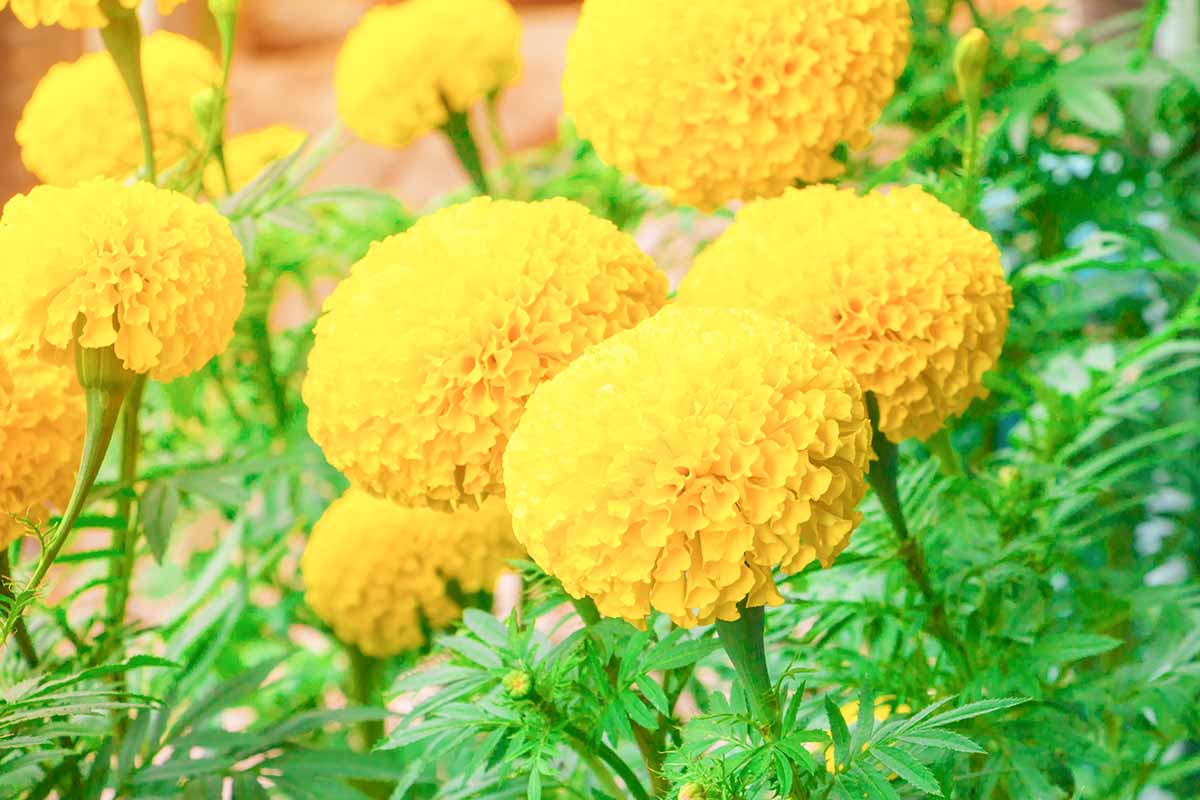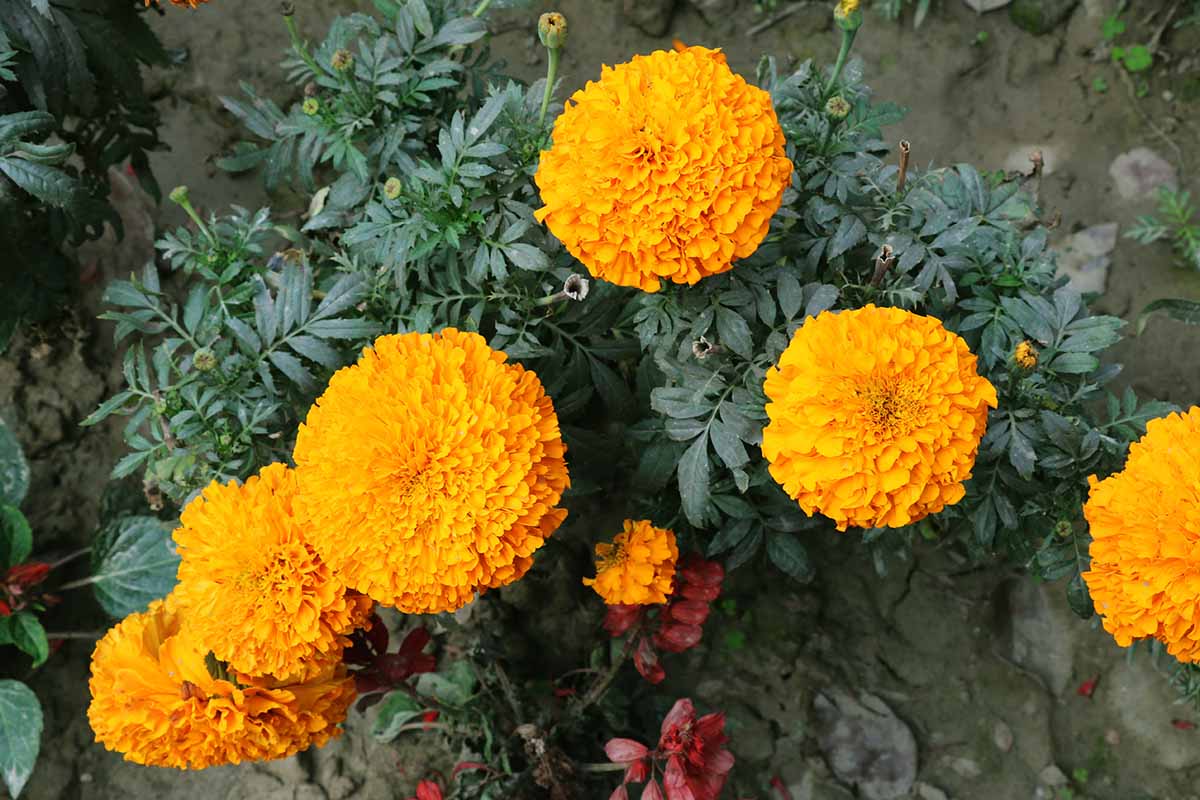Tagetes erecta, or African marigolds, belong to the same genus as other marigolds, and they share many similar features and care requirements. We link to vendors to help you find relevant products. If you buy from one of our links, we may earn a commission. African marigolds can thrive in many types of soil, have a long blooming season, and are incredibly hardy. These marigolds have also been used for thousands of years by Spanish and pre-Spanish civilizations for food, medicine, dyes, and rituals. In this guide we’ll cover how to cultivate African marigolds in your garden. Here’s the lineup: I love this plant because of its many different uses. I’ve seen T. erecta used as a garnish for meals and in crafts when dying fabric. Plus, they have those iconic flower heads that can grow as large as four inches across. There’s something really unique and attractive about a big honkin’ flower head in a bold color! Let’s get started.
Cultivation and History
T. erecta is usually referred to commonly as the African marigold, but it is also known as the Mexican, Aztec, American, or big marigold. Native to Mexico and Central America, these plants are best known for their massive flower heads and long flower stems. They have a rich history in Mexico as the flower of choice for celebrating the Day of the Dead. In Mexico, these huge marigolds have been grown for hundreds of years to decorate the altars of loved ones that have passed on. We also know that the Aztecs grew this species, thanks to seeds found among the ruins in ancient Aztec cities. It’s where this species gets one of its nicknames: the Aztec marigold. And it was cultivated for a variety of purposes, including medicinal, decorative, and ceremonial uses. In the United States, you can grow these annuals in USDA Hardiness Zones 2 to 11. African marigolds bloom from early summer to late fall, and usually grow in a compact and mounded shape, generally reaching 12 to 20 inches tall, but some varieties can grow up to 48 inches in height. They spread between 18 and 24 inches, depending on the cultivar. The showy flowers come in shades of red, orange, gold, yellow, and cream as well as bicolors, and they are absolutely HUGE. The blooms are generally about three inches wide, but some can grow as large as four inches in diameter. The petals are edible, but these are bitter, with a citrusy taste. The foliage is a sage green color, with leaves that are a bit rough and leathery. The orange varieties in particular really pop in contrast with the leaves. The foliage is where the majority of the plant’s fragrance is stored – although the scent is hard to define. I would use the words “musky” and “sharp” to describe it. The fragrance isn’t unpleasant, but it’s certainly distinctive to marigolds. Some might not like the scent – and I would agree it’s an acquired taste.
Propagation
African marigolds can be propagated either from seed or from young nursery starts that will need to be transplanted into your garden. You can generally find seeds online and from nurseries year-round, or harvest them from a mature plant to be sown the following year.
From Seed
Seeds can be sown indoors in a seed tray starting about four to six weeks before your average last frost date. Plant your seeds about a quarter of an inch deep in a seed tray filled with moist, sterile seed-staring mix. I like to plant three seeds per cell to improve the chances of germination. After you’ve sown your seeds, grab a humidity dome and place it on top of the tray, or wrap it in plastic. Germination happens very quickly for marigolds – you will see sprouts in as little as five to 10 days. Remove the humidity dome at the first sign of germination. Place the tray in a sunny window or under a good set of grow lights, and keep the soil moist. If you are using a sunny window, turn your seed trays every two or three days to keep your seedlings growing straight – they tend to lean towards sunlight and may fall over if you’re not careful. Thin the seedlings if more than one has sprouted per cell. Move your seedlings outdoors to harden them off about a week before you plan to plant them in your landscape or pot them up outdoors – they do require some time to acclimate to their surroundings. Ideally, you will move your seedlings outdoors two weeks after your last frost date, but no sooner. Directly sowing your seeds into the landscape instead can be done about two weeks after your last average frost date. African marigolds do not like frost, so planning ahead will help to set you up for success! Select a protected and sunny spot within your landscape to sow your seeds. If you’ve selected a cultivar that grows over 16 inches in height, you’ll want to plant in an area that’s sheltered from strong winds, or you will need to stake them. Plant three seeds in the center of each pot, thinning the weakest seedlings after germination. Water thoroughly until the excess flows from the base of your pot, and water again whenever the top two inches of soil are dry. Space your seeds approximately 12 inches apart, planting about a quarter-inch deep, and water deeply. Luster Leaf Round Grow Through Grid Place the grid over the planting area in spring, and it will provide support as the plant grows and blooms. African marigolds can also grow in containers. Select one eight-inch container per plant, and pick a pot that has good drainage. I like to cover the bottom with a thin layer of grit or gravel, or you could use a potting screen. This will ensure the hole won’t become obstructed, allowing excess water to flow through. See our guide to propagating marigolds from seed for more tips.
From Seedlings/Transplanting
African marigold seedlings and young plants can be found in local nurseries or garden centers in early spring. Two weeks after your last frost date, move any seedlings you’ve started yourself outdoors to harden them off. Dig a hole twice as wide and deep as the root ball and place the transplant into the hole. Backfill with soil amended with a handful of compost and water in well. African marigolds need to be spaced about 12 inches apart.
How to Grow
African marigolds require the basics: full sun, regular water when the soil is dry, and a bit of fertilizer to keep the flowers going strong through November.
Growing Tips
Plant in full sun.Provide well-draining, moderately fertile soil.Taller varieties may need to be staked, or you can plant in an area protected from wind.Provide a slow-release fertilizer after flower production begins, and again in September in Zones 8 and above.
Maintenance
To promote continuous flowering, remove spent blooms by deadheading as often as possible. You’ll want to fertilize after they’ve started pushing out blooms in early June, and again in early September if you’re gardening in Zones 8 and above. Burpee All Purpose Fertilizer This 4-4-4 (NPK) all-purpose, slow-release, balanced fertilizer that’s available from Burpee will feed your plants for up to three months. When it comes to fertilizing your marigolds, be careful not to add too much nitrogen to the soil as this will result in a plant with bushier growth and fewer flowers. Not only will this encourage your African marigold to keep pushing out blooms, it will also prevent the plant from putting unnecessary energy into seed production. Blooming will usually begin in late May and last through October or early November. If you’d like to collect seeds for planting the following spring, stop deadheading in late September so you’ll have seeds ready right before the early winter frosts hit. Apply two inches of your preferred organic mulch around the base of your plants for moisture retention and to prolong the amount of time that you can wait between waterings.
Managing Pests and Disease
All Tagetes species tend to have similar issues with pests and disease, and African marigolds are no exception. You can find both seeds and young transplants either online or at your local nursery. If your nursery does carry them, you can expect them to hit the shelves around early spring. Seeds are generally sold year-round.
Crackerjack
If you love a colorful blend of blooms, plants in the Crackerjack series produce four-inch blooms in orange, gold, and lemony yellow. These will grow tall and proud, reaching 24 to 36 inches in height. Choose a suitable location that is protected from wind, or stake them in to keep the plants from falling over. Crackerjack Series Packets of conventional and organic Crackerjack seeds are available in a mix of colors from Botanical Interests.
Discovery
Orange marigolds are so iconic and classic. The Discovery series is made up of dwarf plants with a mounding habit that reach about 10 inches tall. The blooms are still huge, though – about three inches wide. Discovery Series You can grab seeds for this variety in orange from True Leaf Market. Yellow or a mix of colors are available as well, in a variety of package sizes.
Gold Inca II
The blooms on some of these varieties can be big, so I wanted to try and find the biggest flowers available. The Inca II series might be the winner. The blooms on these plants can be five inches across, and the plants grow up to 15 inches tall. Amazing! Gold Inca II Series Seeds are available from True Leaf Market in gold, orange, and yellow, or as a mix.
Lemon Supreme
‘Lemon Supreme’ is a variety that looks as bright and refreshing as it sounds, with ruffled petticoat petals in a stunning shade of yellow. The blooms are slightly smaller than those of other varieties, and they grow between two and three inches wide on plants that reach 24 to 30 inches tall.
Pineapple Imp
If you want a marigold that is as bright as the morning sun, I’d like to introduce ‘Pineapple Imp.’ This cultivar from the Crush series has four-inch-wide blooms in lemon yellow and the plants will grow a tidy 10 to 12 inches tall. ‘Pineapple Imp’ Seeds are available from True Leaf Market.
Vanilla
‘Vanilla’ is a cultivar with delicate white blooms that grow about three inches wide. They make a good contrast plant within your landscape or in a bouquet of cut flowers. They would also make a wonderful addition to a cottage garden border. ‘Vanilla’ If you want to add this cultivar to your garden, you can find ‘Vanilla’ seeds from True Leaf Market. You might also find certain varieties of African marigolds that have been hybridized with French marigolds. These hybrids can result in some stunning blossom colors. ‘Konstance’ is a bicolor red and orange-flowered cross of T. patula and T. erecta that you might like, with large blooms that look similar to French marigolds in form.
Pests
Some of the more common insect pests and gastropods that may visit your plants include:
Slugs and Snails
Slugs and snails are attracted to marigolds and will happily munch on your plants. You can expect these creepy-crawlies to come out at night, or during overcast days when it’s cool. While I agree these pests are a nuisance, it’s important to deal with them with organic solutions as much as possible, particularly because snails and slugs provide food for birds. Let’s talk about my favorite way to manage snails organically: beer traps. Beer trapping is pretty straightforward. Grab a shallow dish from your kitchen, fill it with beer, and place it on the ground near the affected garden area. The slugs and snails will be attracted to the beer, drop into the trap, and then drown. The next day, you can remove the dead critters from your beer trap and refill it with more cheap beer. Repeat until you no longer have a snail or slug problem! Learn more about how to deal with these gastropods in our guide.
Spider Mites
Spider mites are bad news for marigolds. They generally become an issue during the hottest days of summer. Symptoms of a spider mite infestation are leaf color loss and you may notice fine webbing on the plant’s foliage and blooms. These tiny pests can be difficult to see, but when you know, you know! You can treat a spider mite infestation organically with repeat applications of neem oil. Neem oil is an organic pest control method that works wonders. It’s incredible! However, it does work best if applied at the first sign of an infestation. Neem oil is often sold in a concentrated form that needs to be mixed with water and sprayed with a spray bottle, though ready-to-spray options are also available.
Disease
African marigolds show good disease resistance, but they are susceptible to botrytis blight, leaf spot, powdery mildew, and root rot. Bonide Neem Oil A high-quality neem oil concentrate from Bonide is available from Arbico Organics.
Thrips
Thrips are tiny insects in the Thysanoptera order, and you can recognize an infestation by signs of scarring on the flowers or deformed leaves. Like spider mites, thrips can be treated with neem oil as described above. Check out our guide to learn more about how to deal with thrips. Botrytis Blight Botrytis is a fungal disease that may affect the leaves, buds, and flowers of your African marigolds. I wouldn’t wish this fungal issue on my worst enemy. If the infection persists, you’ll need to remove your plants and start afresh in a new location in your garden or with new soil and sanitized pots. Prune off and dispose of affected plant parts – do not place them on your compost pile. Regalia Biofungicide After pruning and disinfecting your tools, treat your marigolds with a broad-spectrum biofungicide, such as Regalia, available from Arbico Organics. This product is made with an extract of giant knotweed (Reynoutria sachalinensis). Follow the directions on the product packaging for application instructions.
Bacterial Leaf Spot
Leaf spot – argh! Another awful disease in the garden. As mentioned above, treating your plants with a preventative biofungicide will help to keep you ahead of both fungal and bacterial diseases in the garden. Unfortunately, if you suddenly find evidence of bacterial leaf spot, you will need to destroy the affected plant to keep the disease from spreading throughout your landscape. Remove the plant and surrounding dirt, and dispose of it by burning it or throwing it in the trash. Do not place the diseased plant in your compost bin and make sure to disinfect your tools.
Powdery Mildew
Powdery mildew is an easier fungal disease to control, and it affects all different kinds of plants. The most common symptom is a powdery white dusting that covers a plant’s foliage and blooms. A simple mixture of water, baking soda, and a dash of dish soap may help to rid your plant of mildew. Mix one tablespoon of baking soda with half a teaspoon of liquid dish soap in a gallon of water. Take this mixture outside and absolutely drench your marigold’s foliage with it, using a spray bottle. Let the mixture dry on the foliage and reapply again in seven days. You can read about more natural and homemade remedies for powdery mildew in our guide.
Root Rot
You’ll know your African marigolds have root rot if they start to wilt suddenly, or the leaves turn yellow. Your plant will look sickly, but don’t worry just yet – marigolds are pretty hardy. Generally root rot is a sign that you’ve overwatered your marigolds, or that they are planted in the wrong soil. Remove your African marigold from its environment, and remove any dead or dying plant parts with a sterile pair of shears or garden scissors. Replant in a location where the soil is more porous, or add grit or horticultural sand to the existing soil to improve drainage. If planted in a pot, it may help to add a thin layer of gravel to the base as well, covering the drainage hole. I find this can help with drainage by ensuring the soil won’t get lodged in the drainage hole, preventing excess water from flowing freely. Always be sure to place a drainage dish underneath pots, and dump it out after watering. And never choose a pot without a drainage hole – these can be used as decorative cachepots instead if you like, with a nursery container or something else with good drainage placed inside.
Best Uses
Probably the best-known use for African marigolds is interplanting them within a vegetable garden to help deter pests. In fact, this gardening tactic has been used for centuries. The scent of marigolds deters many types of harmful insects and herbivores, and chemicals released by the plant are toxic to harmful root-knot nematodes. The blooms of T. erecta are edible and can be used as a garnish in a salad, or as a natural food colorant. The taste is best described as bitter and citrusy, so you may also like to use the flowers to garnish cocktails. Always be sure to only select plants that have been grown for edible use if you plan to pick them to eat, and avoid any that have been sprayed with potentially harmful chemicals. If you’re the crafty type, these marigolds have long been used to create natural dyes. Depending on the color of flowers you’ve chosen, the resulting dyes will have shades of orange, yellow, or gold. These can be used to dye fabric or yarn. African marigolds work well in border plantings in a variety of different landscape styles, from cottage to coastal. This is due to their ability to tolerate many different types of environments, and their high tolerance to heat. They also do well in containers, on their own or in mixed plantings with other species that share similar requirements. The taller varieties look great in cut flower gardens, and they’re well-suited to use in bouquets and arrangements. In my own research, I’ve read that farmers will feed the blooms of African marigolds to their poultry in order to enhance the golden color of the egg yolks, as well as their beaks and their feet. There are other benefits to feeding this plant to chickens too, as a valuable source of antioxidants. If you keep chickens this is definitely worth checking out. Fascinating! These vigorous plants are easy to grow from seed and they only require some water, full sun, and a stake or two for support if they grow tall. For beginner gardeners, African marigolds offer an easy way to learn more about ornamental and edible flowers. They also work well for those with chickens that want to grow something for their pets or livestock to enjoy. Are you growing African marigolds? Let us know your experience in the comments section below and feel free to share your tips! Want to read more about caring for marigolds? Check out these articles next:
17 of the Best Marigold Companions31 of the Best Types of MarigoldsHow to Plant and Grow Signet Marigolds


